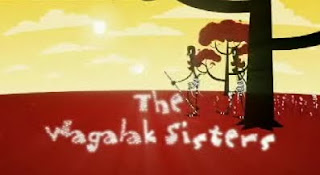The story of the Wagalak Sisters from the ABC website, under Dusk echoes.http://www.abc.net.au/
The story is about two sisters who create, well, everything. One of the sisters has a baby, then they get eaten by a dingo. Am a little confused; I thought Dreamtime stories had a point. I thought the stories were meant to explain how things had come to be, ie, why the crow is black.
I have a couple issues with this site (old lady is emerging): Firstly, in a classroom setting, why do students need a story read to them on the computer? Maybe if they've got some free time they could watch it? While technology surpasses many traditional means, reading a book to children is not one of them. Secondly, I have politically based issues with this site. I like the idea behind, make indigenous culture readily available: ace. But who was in charge of this? The imagery? The narration? Where indigenous Australians heavily involved in the decision making processes? Doubt it.
I have a couple issues with this site (old lady is emerging): Firstly, in a classroom setting, why do students need a story read to them on the computer? Maybe if they've got some free time they could watch it? While technology surpasses many traditional means, reading a book to children is not one of them. Secondly, I have politically based issues with this site. I like the idea behind, make indigenous culture readily available: ace. But who was in charge of this? The imagery? The narration? Where indigenous Australians heavily involved in the decision making processes? Doubt it.
Finally, it took Greg and I a really long time to upload my version of the Mermaid from the ABC/Dusk Echoes.

M and Ms count: Count the number of m and ms in a packet then transfer that information into a graph using excel. I liked this exercise, it demonstrated how easy it is to incorporate ICT into the classroom experience. Using technology in the class adds another layer onto the learning experience; they learn what is set out by their teacher, but they also get to practise and enhance their technological skills.




